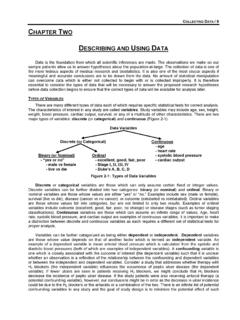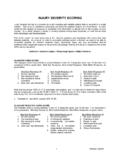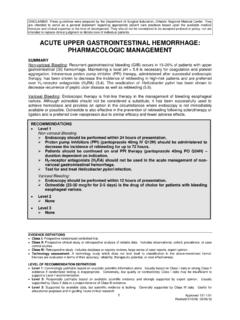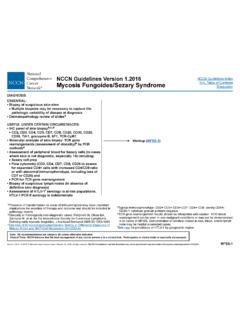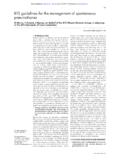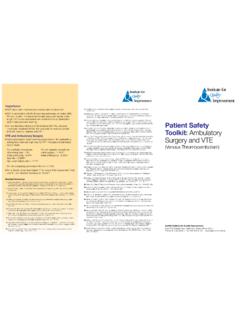Transcription of DVT PROPHYLAXIS IN SOLID ORGAN INJURY
1 DISCLAIMER: These guidelines were prepared by the Department of Surgical Education, Orlando Regional Medical Center. They are intended to serve as a general statement regarding appropriate patient care practices based upon the available medical literature and clinical expertise at the time of development. They should not be considered to be accepted protocol or policy, nor are intended to replace clinical judgment or dictate care of individual patients. EVIDENCE DEFINITIONS Class I: Prospective randomized controlled trial. Class II: Prospective clinical study or retrospective analysis of reliable data. Includes observational, cohort, prevalence, or case control studies. Class III: Retrospective study. Includes database or registry reviews, large series of case reports, expert opinion. Technology assessment: A technology study which does not lend itself to classification in the above-mentioned format. Devices are evaluated in terms of their accuracy, reliability, therapeutic potential, or cost effectiveness.
2 LEVEL OF RECOMMENDATION DEFINITIONS Level 1: Convincingly justifiable based on available scientific information alone. Usually based on Class I data or strong Class II evidence if randomized testing is inappropriate. Conversely, low quality or contradictory Class I data may be insufficient to support a Level I recommendation. Level 2: Reasonably justifiable based on available scientific evidence and strongly supported by expert opinion. Usually supported by Class II data or a preponderance of Class III evidence. Level 3: Supported by available data, but scientific evidence is lacking. Generally supported by Class III data. Useful for educational purposes and in guiding future clinical research. 1 Approved 12/04/2013 DVT PROPHYLAXIS IN SOLID ORGAN INJURY SUMMARY It is well established that deep venous thrombosis (DVT) and pulmonary embolism (PE) are known complications in trauma patients.
3 There is significant evidence to support that DVTs form early and frequently in trauma patients. This patient population is at high risk for both bleeding and clotting. Therefore, a careful evaluation of the patient is essential to ensure that they are no longer bleeding, hypothermic, or coagulopathic before initiating PROPHYLAXIS for DVT and PE. Safely starting PROPHYLAXIS soon after traumatic INJURY is critical to preventing the formation of DVT. INTRODUCTION It is accepted and advised that anticoagulation ( PROPHYLAXIS ) for DVT and PE should be started as soon as possible after the initial trauma. The consensus opinion is that as soon as the patient is no longer coagulopathic and is hemodynamically stable without evidence of ongoing hemorrhage, the patient should be started on DVT PROPHYLAXIS . If the patient has a concomitant head INJURY , the predominant opinion is to wait 24 hours and to have a radiographically stable CT of the head before initiating PROPHYLAXIS .
4 There are multiple trials that address when DVTs and PEs form. There are also many trials that evaluate the use of Heparin, SCDs, and foot pumps. These areas have been well studied, but, to date, there have been no clear guidelines published on when to start PROPHYLAXIS in trauma patients with SOLID ORGAN injuries for DVT. RECOMMENDATIONS Level 1 None Level 2 Enoxaparin 30 mg subcutaneous q 12 hours is the appropriate chemoprophylaxis dose for high-risk trauma patients (adjust for renal impairment) Level 3 Chemoprophylax trauma patients with SOLID ORGAN injuries within 24 hours of admission if there is no evidence of ongoing bleeding No coagulopathy on lab exam (TEG or PT/PTT/INR/platelet assay) No blush on CT scan or signs of active hemorrhage Use Heparin 5000 units SQ q 8 hours in patients with traumatic brain or spinal cord INJURY Patients should not be placed on bedrest based solely upon their grade of SOLID ORGAN INJURY Mobilize patients out of bed on post trauma day one unless otherwise contraindicated Sequential Compression Devices (SCDs)
5 Or foot pumps should be used on all patients when chemoprophylaxis is contraindicated 2 Approved 12/04/2013 LITERATURE REVIEW DVT PROPHYLAXIS in trauma patients With regard to SOLID ORGAN injures without head INJURY , O Malley et al demonstrated that one fourth of all DVT and PEs occur on or before day number four post-trauma. This illustrates that clots form much earlier than the traditional teaching of seven days. The more severely injured the patient, the higher the probability of DVT and PE formation. The vast majority of trauma surgeons and critical care intensivists are apprehensive about early DVT PROPHYLAXIS out of concern for possible bleeding. In trials to date, however, there has been no statistically significant bleeding difference between patients who receive DVT PROPHYLAXIS and those that do not. The data further supports that early DVT PROPHYLAXIS does not lead to a higher failure rate in SOLID ORGAN INJURY salvage (Demetriades et al).
6 The essential question is what to use and when to initiate therapy? An analysis of the different options has proven that SCDs and foot pumps should be used whenever feasible if chemoprophylaxis is contraindicated. SCDs have two distinct mechanisms of action. The first is to augment the calf pump and to increase the flow through the femoral veins. This flow can be increased up to 240% from resting levels in trauma patients with the use of these devices. The secondary mechanism is not as clearly understood. The vein walls contain antithrombotic factor that is released with manual compression. The amount and efficacy of the antithrombotic factor is not well understood. The drawback to these devices is that once the devices are removed, the protective effects dissipate within one hour. Pressure foot pumps work by augmenting blood flow from the gravity dependent venous plexus in the sole of the feet.
7 This was first described in 1983 by Gardener and Fox. Both of these devices have not been shown to have any measureable advantage in reducing DVT/PE in trauma patients with SOLID ORGAN injuries. The caveat is that in subgroup analysis, head INJURY and spinal cord INJURY patients have shown a mild reduction in formation of DVT and PEs. The real advantage is that they do not have any potential to add to the bleeding risk. Velahamos et al. showed in a prospective trial that low molecular weight heparin (30 mg sq q 12 hours) was superior to heparin (5000 units sq q 8 hours) in DVT/PE PROPHYLAXIS . Low molecular weight heparin reduced the number of DVTs and PEs without any significant increase in bleeding risk. A retrospective study supports early low molecular weight heparin use in trauma patients on admission. In this study they held the low molecular weight heparin for 24 hours in patients with head injuries.
8 Once the patients had stable imaging of the brain, they started PROPHYLAXIS . There is a paucity of further prospective trials to corroborate this data. The preponderance of expert opinion and paucity of prospective data suggest that the drug of choice for anticoagulation of trauma patients with SOLID ORGAN injuries is low molecular weight heparin 30 mg sq q 12 hours. The one exception is in the subgroup of trauma patients with spinal cord and traumatic brain injuries where heparin may have an advantage in that it can be reversed more easily than can low molecular weight heparin should bleeding occur. Experts all agree that early anticoagulation is the goal. The difficulty is in defining a set of criteria that illustrate the patient is no longer bleeding and it is safe to start PROPHYLAXIS . With regard to SOLID ORGAN INJURY , there should not be a blush or vascular extravasation of contrast on CT scan.
9 The patient should have no other signs of active bleeding ( blood in the Foley catheter, NGT, or chest tube). The patient should be hemodynamically stable, normothermic, and proven by laboratory testing not to be coagulopathic (either by TEG or PT/PTT/INR/PFA). Studies have shown that when patients have a core temp of 32 C, they have a 50% prolongation in coagulation time. There is further elongation when combined with acidosis. These conditions can have a profound effect on coagulation time. The EAST consensus statement on DVT PROPHYLAXIS as well as multiple articles (Level III data) discourages the use of prophylactic inferior vena cava filters. They cite that the filters themselves come with inherent problems of promoting DVT formation as well as clogging . This leads to lower extremity edema and venous stasis. This further promotes a hypercoagulable state and thrombus formation. Vena 3 Approved 12/04/2013 cava filters should be reserved for those individuals who cannot be anticoagulated or have failed appropriate medical therapy.
10 There appears to be no evidence to support prophylactic bedrest or waiting to start PROPHYLAXIS in trauma patients with SOLID ORGAN injuries. There is no data to support an increased salvage rate in non-operative management of SOLID ORGAN injuries by doing either of the above. There is no evidence to support that DVT PROPHYLAXIS will lead to an increased rate of SOLID ORGAN INJURY non-operative management failures or increased bleeding requiring intervention. REFERENCES 1. Attia J, Ray JG, Cook DJ, Douketis J, Ginsberg JS, Geerts WH. Deep vein thrombosis and its prevention in critically ill adults. Arch Intern Med. 2001; 161(10):1268-1279. 2. Chiasson TC, Manns BJ, Stelfox HT. An economic evaluation of venous thromboembolism PROPHYLAXIS strategies in critically ill trauma patients at risk of bleeding. PLoS Med. 2009;6(6):e1000098. 3. Imberti D, Ageno W. A survey of thromboprophylaxis management in patients with major trauma.



